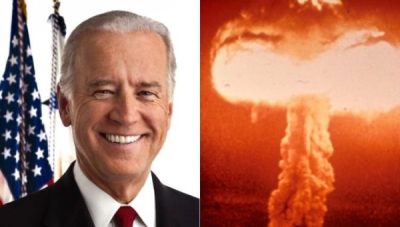Is the US Convinced That “We Can Win a ‘Simultaneous, First Strike’ Nuclear War”. “The Need to deter Russia, China and North Korea”
Biden's "Nuclear Employment Guide".

The globalist establishment would outline for the next five years a plan that would involve the recovery of the US role as a global gendarme. This will done through an extraordinary increase in US military interventions abroad to recover the Unipolarity on the global geopolitical board, following the Wolfowitz Doctrine, which outlined “a policy of unilateralism” and “preventive military action to suppress possible threats from other nations and prevent dictatorships from rising to the status of a superpower”, which implies a simultaneous lightning-fast nuclear attack by the United States against China, Russia and North Korea.
Biden and the “Nuclear Employment Guide”
According to the New York Times, President Joe Biden approved a highly classified nuclear strategic plan in March called the “Nuclear Employment Guide”. The plan
” aims, for the first time, to prepare the United States for possible coordinated nuclear challenges by China, Russia and North Korea and for the first time redirects the US deterrence strategy to focus on the rapid expansion of China’s nuclear arsenal”.
And according to the American newspaper, “this change occurs when the Pentagon estimates that China’s reserves will rival in size and diversity with those of the US and Russia over the next decade”.
China’s nuclear expansion would have raised alarm bells in the Pentagon as it would move faster than expected by US intelligence officials due to the change implemented by President Xi Jinping after abandoning the old strategy of maintaining a “minimum deterrent” and adopt the Nuclear Triad Doctrine of “matching or exceeding the size of the Russian and US nuclear arsenals by 2035”.
Since the presidency of Harry Truman, this strategy has focused mainly on the Kremlin’s arsenal but for the first time, China appears in Biden’s new guidelines before the evidence of a change in the world nuclear cartography, as the new strategy emphasizes “the need to simultaneously deter Russia, the People’s Republic of China and North Korea”. Thus, according to estimates by the Pentagon, China’s nuclear strength would increase to 1,000 nuclear warheads by 2030 and to 1,500 by 2035; so that the Chinese nuclear arsenal would equal the number of nuclear warheads currently owned by both the US and Russia and would sign up to part of the new nuclear Triad, with which the US nuclear arsenal would be in direct inferiority against the Russian-Chinese axis in case of nuclear conflagration.
Is the US Convinced That We Can Win a Nuclear War?
In an article published at the Quincy Institute entitled “Reflection on Nuclear War, Biden’s new nuclear strategy and the super-fuse that activates it,” MIT Dr. Theodore Postol states that
“It is now possible, at least according to nuclear war fighting strategies, that the US will attack the more than 300 silo-based ICBMs that China has been building since about 2020 with the copious number of 100 kt Trident II W-76 warheads available. The rapid expansion of the W-76’s 100 kt hard-target killing capability also makes it possible for the United States to simultaneously attack the approximately 300 Russian ICBM based in silos”.
So, “the superwarheads now being loaded into US missiles would be specifically designed for a simultaneous, first-strike, lightning nuclear attack on Russia, China and North Korea, to eliminate its capacity for retaliation and thus win a Third World War and then take control of the entire world”, to proceed then to the implementation of the New World Order following the doctrine of Zbigniew Brzezinski.
*
Click the share button below to email/forward this article to your friends and colleagues. Follow us on Instagram and Twitter and subscribe to our Telegram Channel. Feel free to repost and share widely Global Research articles.
Get Your Free Copy of “Towards a World War III Scenario: The Dangers of Nuclear War”!
Germán Gorraiz López is a political analyst. He is a regular contributor to Global Research.
Featured image is from The Unz Review

